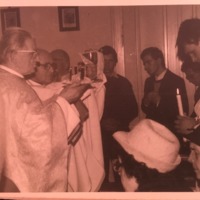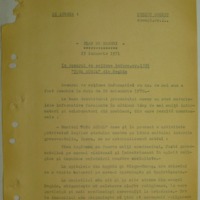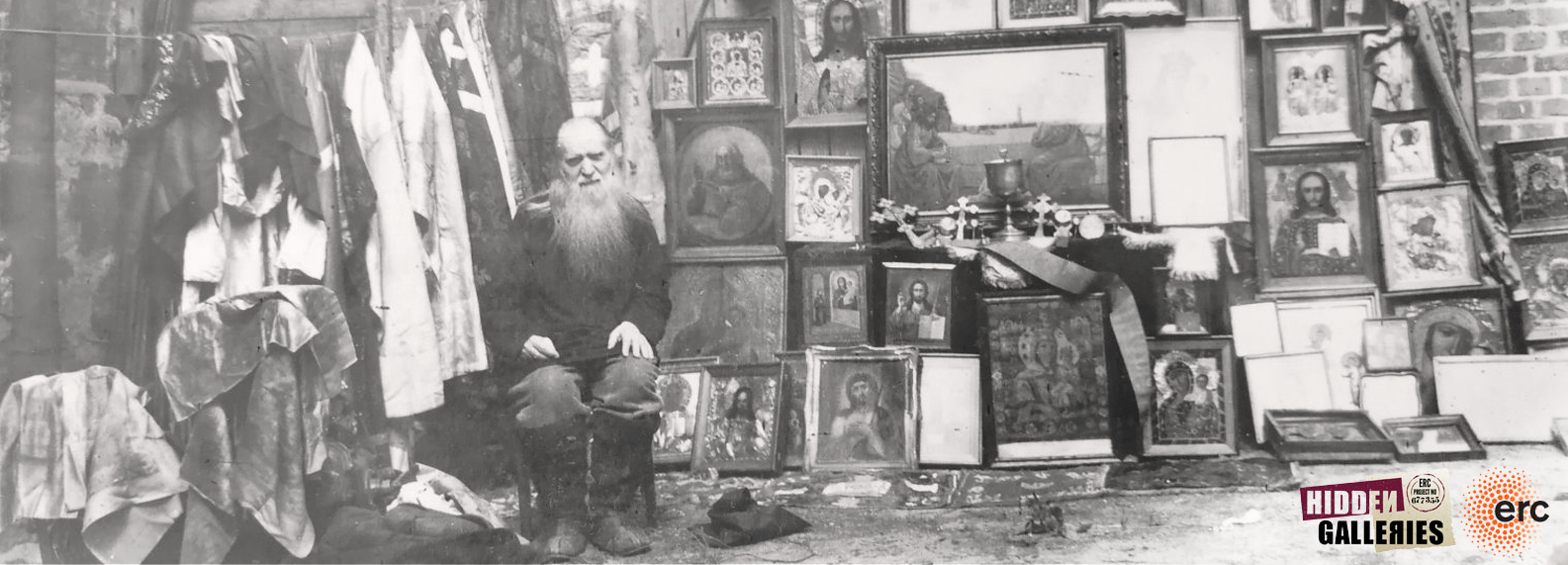Images of clandestine Greek Catholic services in Transylvania
Item
Title
Images of clandestine Greek Catholic services in Transylvania
Imagini ale unor servicii religioase greco-catolice clandestine în Transilvania
Description
The four images illustrate the religious life of a Greek Catholic community in 1970s Transylvania as recorded by the community in photographs and how it is described by the Securitate on the basis of their surveillance and investigation of the community. These materials represent a rare instance where it has been possible to relate secret police descriptions to photographic materials that can still be found in the community. The first three images come from the private collection of Mihai and Ana Rus and form part of a group of photos related to their regular attendance at religious services in Bishop Todea’s house in Reghin where the bishop had also held their wedding and administered the Baptism and the Confirmation of their children. The Rus family could not pinpoint the exact date when they received the photos nor when they were taken. The fourth image is the first page of a Securitate document dated 23rd January 1971 that describes the situation of the clandestine Greek Catholic community in Reghin, Mureș county, a town near to the Rus family's home village, and the planned measures to be taken against the Greek Catholic community in the area.
The first picture from the Rus family collection is a staged photograph of Greek Catholic Bishop Alexandru Todea in the period after his return from prison (1964) when he lived in the town of Reghin in Mureș county. The picture shows Todea in bishop's vestments in a staged, still photograph. His hands are clasped in prayer and is smiling softly towards the camera. The picture was probably taken at his request and served as reminder for the underground community that he ministered spiritually that he was alive and performing his pastoral duties. Moreover, it showed that his church, which had been dismembered by the communist regime in 1948, was still functioning.
Descriptions of similar photographic devotional materials appear in Todea’s Securitate Informative file. Secret police agents and informers talk about a distribution network of pictures of Alexandru Todea within the Greek Catholic community. The documents also mention that a monetary value was placed on the photos of 3 lei. However this information was not verified in the interviews the Securitate carried out.
The second picture was taken during The Great Entrance stage of the liturgy that was conducted in Alexandru Todea’s house. The picture shows an unidentified Roman Catholic priest dressed in Roman Catholic liturgical vestments holding the chalice (and therefore heading the procession) and a Greek Catholic priest (probably Fr. Augustin Giurgiu) holding the disk (ceremonial plate) with the unconsecrated Holy Body of Christ (the Prosphora). The picture shows that in this particular Byzantine service, the Roman Catholic priest holding the chalice leads the liturgy. The picture also shows a well-attended service with several kneeling women and men.
The third picture was taken during a religious service in Bishop Todea’s house in Reghin. It is a snapshot of a detail of the back of the priest dressed in vestments during the Gospel reading. There is a clear image of three church goers, one kneeling holding a candle, probably the acolyte or alter server (or făt in Romanian).
The fourth image is the first page of the Securitate's description of the religious life we see depicted in the Rus family's personal collection. At the bottom of the page the document states that Bishop Alexandru Todea (secret police code name Toma Aurel) performed religious services all over the town as well as in his house. Wedding ceremonies also took place in his house.
The photographic images come from the private photo collection of Mihai and Ana Rus from Băița village, Mureș county, and were shown to the author during ethnographic fieldwork in August, 2018. The family also described religious life and practices of the community during the period when the photographs were taken. The family photo collection contains several photographs that are described in the secret police files on Bishop Alexandru Todea.
The image of the Securitate document is part of the file CNSAS I3470. The Informative file on Bishop Alexandru Todea contains several descriptions of the altar in his house, the religious services performed there and surveillance pictures of people visiting the bishop.
For related entries see:
The first picture from the Rus family collection is a staged photograph of Greek Catholic Bishop Alexandru Todea in the period after his return from prison (1964) when he lived in the town of Reghin in Mureș county. The picture shows Todea in bishop's vestments in a staged, still photograph. His hands are clasped in prayer and is smiling softly towards the camera. The picture was probably taken at his request and served as reminder for the underground community that he ministered spiritually that he was alive and performing his pastoral duties. Moreover, it showed that his church, which had been dismembered by the communist regime in 1948, was still functioning.
Descriptions of similar photographic devotional materials appear in Todea’s Securitate Informative file. Secret police agents and informers talk about a distribution network of pictures of Alexandru Todea within the Greek Catholic community. The documents also mention that a monetary value was placed on the photos of 3 lei. However this information was not verified in the interviews the Securitate carried out.
The second picture was taken during The Great Entrance stage of the liturgy that was conducted in Alexandru Todea’s house. The picture shows an unidentified Roman Catholic priest dressed in Roman Catholic liturgical vestments holding the chalice (and therefore heading the procession) and a Greek Catholic priest (probably Fr. Augustin Giurgiu) holding the disk (ceremonial plate) with the unconsecrated Holy Body of Christ (the Prosphora). The picture shows that in this particular Byzantine service, the Roman Catholic priest holding the chalice leads the liturgy. The picture also shows a well-attended service with several kneeling women and men.
The third picture was taken during a religious service in Bishop Todea’s house in Reghin. It is a snapshot of a detail of the back of the priest dressed in vestments during the Gospel reading. There is a clear image of three church goers, one kneeling holding a candle, probably the acolyte or alter server (or făt in Romanian).
The fourth image is the first page of the Securitate's description of the religious life we see depicted in the Rus family's personal collection. At the bottom of the page the document states that Bishop Alexandru Todea (secret police code name Toma Aurel) performed religious services all over the town as well as in his house. Wedding ceremonies also took place in his house.
The photographic images come from the private photo collection of Mihai and Ana Rus from Băița village, Mureș county, and were shown to the author during ethnographic fieldwork in August, 2018. The family also described religious life and practices of the community during the period when the photographs were taken. The family photo collection contains several photographs that are described in the secret police files on Bishop Alexandru Todea.
The image of the Securitate document is part of the file CNSAS I3470. The Informative file on Bishop Alexandru Todea contains several descriptions of the altar in his house, the religious services performed there and surveillance pictures of people visiting the bishop.
For related entries see:
Cele patru imagini ilustrează viața religioasă a unei comunități greco-catolice din Transilvania anilor '70, așa cum a fost înregistrată de comunitate în fotografii și modul în care este descrisă de Securitate pe baza supravegherii și investigării comunității. Aceste materiale reprezintă un caz rar în care a fost posibil să se coreleze descrierile poliției secrete cu materiale fotografice care încă pot fi găsite în comunitate. Primele trei imagini provin din colecția privată a lui Mihai și Ana Rus și fac parte dintr-un grup de fotografii legate de prezența lor regulată la slujbele religioase din casa episcopului Alexandru Todea din Reghin, unde episcopul oficiase și nunta lor și a înfăptuit botezul și mirungerea copiilor lor. Familia Rus nu a putut identifica data exactă când au primit fotografiile și nici când au fost făcute. A patra imagine este prima pagină a unui document al Securității din 23 ianuarie 1971 care descrie situația comunității greco-catolice clandestine din Reghin, județul Mureș, un oraș situat lângă satul natal al familiei Rus și măsurile planificate care trebuie luate împotriva comunității greco-catolice din zonă.
Prima fotografie din colecția familiei Rus este o fotografie a episcopului greco-catolic Alexandru Todea în perioada de după întoarcerea din închisoare (1964), când locuia în orașul Reghin din județul Mureș. Imaginea îl prezintă pe Todea în veșmintele episcopului într-o fotografie statică, în scenă. Mâinile lui sunt strânse în rugăciune și zâmbește uşor spre cameră. Poza a fost făcută probabil la solicitarea sa și a servit pentru a anunța comunitatea clandestină de revenirea sa pentru a servi spiritual greco-catolicii din clandestinitate și ași îndeplini îndatoririle pastorale. Mai mult, a arătat că Biserica sa, care fusese dezmembrată de regimul comunist în 1948, încă funcționa.
Descrieri ale fotografiilor folosite ca materiale devoţionale similare apar în dosarul informativ al episcopului Todea de la Securitate. Agenții poliției secrete și informatorii vorbesc despre o rețea de distribuție a imaginilor lui Alexandru Todea în comunitatea greco-catolică. Documentele mai menționează că pe fotografii a fost plasată o valoare monetară de 3 lei. Aceste informații nu au fost verificate în interviurile efectuate de Securitate. Cea de-a doua poză a fost făcută în timpul intrării în liturghia care a fost ținută în casa lui Alexandru Todea. Imaginea prezintă un preot romano-catolic neidentificat îmbrăcat în veșminte liturgice romano-catolice ținând potirul (și, prin urmare, conducând serviciul divin) și un preot greco-catolic (probabil pr. Augustin Giurgiu) ținând discul (platoul ceremonial) cu Sfântul Trup al lui Iisus Hristos (Prosfora). Fotografia demonstrează că în această slujire bizantină, preotul romano-catolic care ține potirul conduce liturghia. Imaginea arată, de asemenea, un serviciu cu participare bună, cu mai multe femei și bărbați îngenuncheați.
A treia poză a fost făcută în timpul unei slujbe religioase în casa episcopului Todea din Reghin. Este un instantaneu al unui detaliu din spatele preotului îmbrăcat în veșminte în timpul citirii Evangheliei. Este o imagine clară a celor trei enoriași, unul îngenuncheat ținând o lumânare, probabil slujitor al altarului ( făt).
A patra imagine reprezintă prima pagină a descrierii Securității despre viața religioasă pe care o vedem descrisă în colecția personală a familiei Rus. În partea de jos a paginii, documentul afirmă că episcopul Alexandru Todea (numele de cod al poliției secrete Toma Aurel) a ținut slujbe religioase în tot orașul, precum și în casa sa. În casa lui au avut loc și ceremonii de nuntă.
Imaginile fotografice provin din colecția foto privată a lui Mihai și Ana Rus din satul Băița, județul Mureș, și au fost arătate autorului în timpul lucrărilor de teren etnografice din august 2018. Familia a descris și viața religioasă și practicile comunității din perioada în care au fost făcute fotografiile. Colecția de fotografii de familie conține mai multe fotografii care sunt descrise în dosarele poliției secrete despre episcopul Alexandru Todea.
Imaginea documentului Securității face parte din dosarul CNSAS I3470. Dosarul informativ al episcopului Alexandru Todea conține mai multe descrieri ale altarului din casa sa, serviciile religioase efectuate acolo și imagini de supraveghere ale persoanelor care îl vizitează pe episcop.
Pentru rubrici similare, vezi:
Subject
Communism--Romania--History--20th century
Romania. Securitatea
Catholic Church--Byzantine rite, Greek
Communism and religion
Surveillance
Material culture--Religious aspects
Creator
Anca Sincan
Source
Consiliul Național pentru Studierea Arhivelor Securității (CNSAS) I3470, vol 3
Private photo collection of Mihai and Ana Rus from Băița village, Mureș county
Publisher
This project has received funding from the European Research Council (ERC) under the European Union’s Horizon 2020 research and innovation programme No . 677355
Date
1970s
Contributor
Anca Sincan
Rights
Copyright for the document image belongs to CNSAS
Consiliul Național pentru Studierea Arhivelor Securității
Consiliul Național pentru Studierea Arhivelor Securității
Copyright for the photo images belongs to Mihai and Ana Rus
Format
jpeg
Language
RO
Type
Image
Text
Identifier
CNSAS I3470
Coverage
20th century, Romania
Bibliographic Citation
Anca Sincan, "Images of clandestine Greek Catholic services in Transylvania"
Date Created
2019
Item sets
 Still image of Greek Catholic Bishop Alexandru Todea
Still image of Greek Catholic Bishop Alexandru Todea  Image of Greek Catholic religious liturgy 1
Image of Greek Catholic religious liturgy 1  Image of Greek Catholic religious liturgy 2
Image of Greek Catholic religious liturgy 2  Image of secret police document
Image of secret police document 